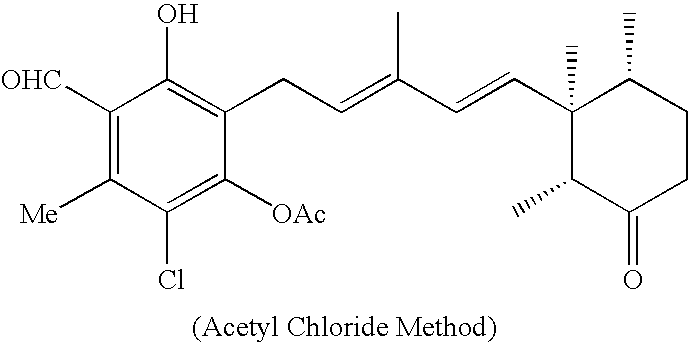Method for preparing novel transcription factors and use
a transcription factor and novel technology, applied in the field of novel transcription factor preparation, can solve the problems of poor nutrient utilization rate, and increased consumption of beef and eggs, and achieve the effects of reducing hypercholesterolemia, hyperglycemia, and hypertension and obesity
- Summary
- Abstract
- Description
- Claims
- Application Information
AI Technical Summary
Benefits of technology
Problems solved by technology
Method used
Image
Examples
example 1
Method for Synthesizing Diacyl Derivatives of Ascochlorin, Cilindochlorin, Ascofuranone, Chloronectin, LLZ-1272-a and LLZ-1272-d
[0028]Ascochlorin and its analogs of 4-O-alkylascochlorins, 4-O-carboxyalkylascochlorins, ascofuranone, cylindrochlorin, chloronectin, LLZ-1272-a and LLZ-1272-d and the like were added to a pyridine / acetic anhydride mixture solution and left to stand at room temperature overnight. The amount of the acetic anhydride added in the pyridine / acetic anhydride mixture solution for acylating ascochlorin and its analogs was in slight excess per one hydroxyl group of the former on a molar basis. After left to stand overnight, the reaction solution was poured into water and about three parts in volume, based on one part in volume of the mixture solution, of ethyl acetate were added to the mixture solution, and the resulting mixture solution was vigorously agitated in a separatory funnel, and the upper layer of the ethyl acetate phase was dispensed. The lower layer was...
example 2
Another Method for Preparing 2,4-Di-O-acetylascochlorin
[0029]Another method using acetyl chloride instead of acetic anhydride is as follows. Ascochlorin (0.300 g, 0.741 mmol) was dissolved in anhydrous pyridine (1.3 ml), and acetyl chloride (0.158 ml, 2.22 mmol) was added dropwise thereto while cooling in a water bath. The reaction solution was agitated at room temperature for four hours, and then a saturated NaHCO3 aqueous solution (2 ml) was added thereto, and the resulting mixture solution was further agitated for 20 minutes. The reaction solution was diluted with water, and then extracted with ether, and the ether layer was washed with a saturated CuSO4 aqueous solution, water and a saturated sodium chloride aqueous solution in the order named, and then dried with anhydrous sodium sulfate. After filtering the desiccant, the filtrate was concentrated under reduced pressure to obtain 0.320 g (88%) of 2,4-di-O-acetylasco-chlorin (as a colorless gum).
[0030]NMR (CDCl3), 500 MHz): 0.1...
example 3
[0031]In the past study, in the investigation of the acylation of ascochlorin and its analogs, it had been found that crystalline 4-O-acyl derivatives could be obtained. Even if 2,4-di-O-acetyl derivatives have been formed in the reaction solution, the acyl group at the 2-position was easily hydrolyzed to return to a hydroxyl group in the purification process. Accordingly, the 2,4-di-O-acyl derivatives which could not be obtained in a crystalline form have hardly been used as starting materials for novel derivatives. In this Example, in order to confirm the formation of the 2,4-di-O-acetyl derivatives, 2,4-di-O-acetylascochlorin (0.1 mmol) was dissolved in a solvent / catalyst of a methanol / triethyl-amine mixture solution for allowing the aldehyde group to react with a primary amine to effect aminocarbonylation, and left to stand at room temperature overnight to try to obtain 4-O-methylascochlorin by partial decomposition of the acyl groups. Surprisingly, the formed product was not 4-...
PUM
| Property | Measurement | Unit |
|---|---|---|
| solubility | aaaaa | aaaaa |
| pH | aaaaa | aaaaa |
| body weight | aaaaa | aaaaa |
Abstract
Description
Claims
Application Information
 Login to View More
Login to View More - R&D
- Intellectual Property
- Life Sciences
- Materials
- Tech Scout
- Unparalleled Data Quality
- Higher Quality Content
- 60% Fewer Hallucinations
Browse by: Latest US Patents, China's latest patents, Technical Efficacy Thesaurus, Application Domain, Technology Topic, Popular Technical Reports.
© 2025 PatSnap. All rights reserved.Legal|Privacy policy|Modern Slavery Act Transparency Statement|Sitemap|About US| Contact US: help@patsnap.com



